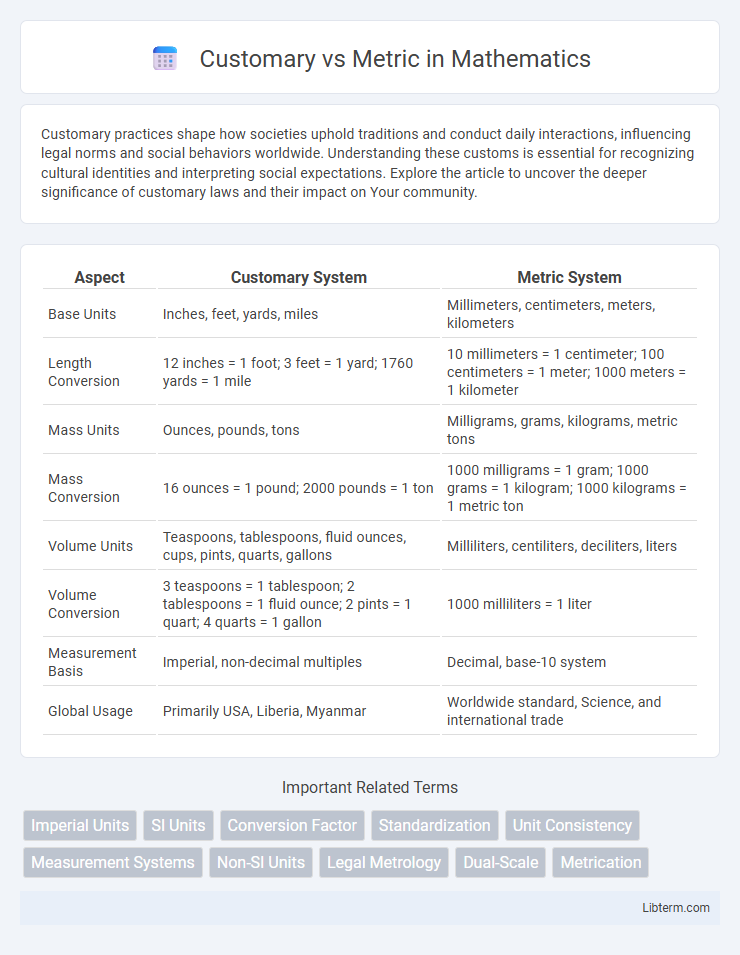Customary practices shape how societies uphold traditions and conduct daily interactions, influencing legal norms and social behaviors worldwide. Understanding these customs is essential for recognizing cultural identities and interpreting social expectations. Explore the article to uncover the deeper significance of customary laws and their impact on Your community.
Table of Comparison
| Aspect | Customary System | Metric System |
|---|---|---|
| Base Units | Inches, feet, yards, miles | Millimeters, centimeters, meters, kilometers |
| Length Conversion | 12 inches = 1 foot; 3 feet = 1 yard; 1760 yards = 1 mile | 10 millimeters = 1 centimeter; 100 centimeters = 1 meter; 1000 meters = 1 kilometer |
| Mass Units | Ounces, pounds, tons | Milligrams, grams, kilograms, metric tons |
| Mass Conversion | 16 ounces = 1 pound; 2000 pounds = 1 ton | 1000 milligrams = 1 gram; 1000 grams = 1 kilogram; 1000 kilograms = 1 metric ton |
| Volume Units | Teaspoons, tablespoons, fluid ounces, cups, pints, quarts, gallons | Milliliters, centiliters, deciliters, liters |
| Volume Conversion | 3 teaspoons = 1 tablespoon; 2 tablespoons = 1 fluid ounce; 2 pints = 1 quart; 4 quarts = 1 gallon | 1000 milliliters = 1 liter |
| Measurement Basis | Imperial, non-decimal multiples | Decimal, base-10 system |
| Global Usage | Primarily USA, Liberia, Myanmar | Worldwide standard, Science, and international trade |
Introduction to Customary and Metric Systems
The Customary system, primarily used in the United States, features units such as inches, feet, pounds, and gallons, originating from British Imperial measures. The Metric system, widely adopted globally, is based on decimal intervals and includes units like meters, kilograms, and liters, facilitating easy conversion and standardization. Both systems serve as fundamental frameworks for measurement but differ significantly in scale, units, and global prevalence.
Historical Background of Measurement Systems
The customary measurement system originated from ancient traditions and regional practices primarily used in the British Empire, reflecting local trade and agricultural needs over centuries. The metric system was developed during the French Revolution in the late 18th century, designed to create a universal, decimal-based system grounded in scientific principles and standard units. Historical adoption patterns show the metric system's global spread due to its simplicity and consistency, contrasting with the customary system's persistence in countries like the United States.
Key Differences Between Customary and Metric Units
Customary units, primarily used in the United States, include inches, feet, pounds, and gallons, while metric units, used globally, rely on meters, kilograms, and liters based on the decimal system. The metric system offers a standardized scale with units scaled by powers of ten, making conversions simpler compared to the Customary system's varied conversion factors. Key differences lie in their measurement bases--metric is universal and decimal-based, whereas customary units are region-specific and derived from historical standards.
Global Usage: Metric vs. Customary
The metric system dominates global usage, adopted by almost every country due to its simplicity and standardization in scientific, industrial, and everyday measurements. Customary units, primarily used in the United States, Liberia, and Myanmar, persist in specific sectors such as construction and trade but are limited in international contexts. The universal preference for the metric system facilitates efficient global communication, trade, and research by providing a consistent measurement framework.
Conversion Challenges and Solutions
Conversion between Customary and Metric systems presents challenges due to differing base units and measurement standards, such as inches to centimeters and pounds to kilograms. Accurate conversions require precise formulas or conversion factors, like 1 inch equaling 2.54 centimeters, to avoid errors in engineering, manufacturing, and scientific applications. Utilizing digital tools, conversion charts, and automated software solutions streamlines the process, ensuring consistency and reducing human error in complex calculations.
Everyday Applications of Both Systems
The customary system, primarily used in the United States, dominates everyday measurements such as inches, feet, pounds, and gallons for cooking, construction, and personal height or weight. The metric system, favored globally, simplifies scientific, medical, and international trade measurements through standardized units like meters, liters, and grams. Familiarity with both systems enhances accuracy and convenience in diverse real-world tasks, from measuring fabric and ingredients to calculating distances and volumes.
Advantages of the Metric System
The Metric System offers universal standardization, enabling seamless global communication and trade across scientific, industrial, and everyday measurements. Its decimal-based structure simplifies calculations and conversions, reducing errors and increasing efficiency in education and professional fields. The system's consistent unit relationships facilitate precision and scalability, making it ideal for technological advancements and international collaboration.
Why Some Countries Use the Customary System
Countries such as the United States continue to use the customary system primarily due to historical precedent and the high cost of transitioning to the metric system. The customary system's deep integration into industries, infrastructure, and everyday life creates significant resistance to change. Despite global trends favoring metrication for its universal standardization and ease of scientific communication, cultural familiarity and economic factors sustain the customary system's usage in these regions.
The Push for Metrication: Trends and Controversies
The push for metrication has gained momentum globally due to the metric system's universal standardization, which facilitates international trade, scientific research, and technological innovation. Despite widespread adoption, resistance persists in countries like the United States, where customary units remain deeply entrenched in daily life and industries, sparking debates over economic costs and cultural identity. Trends show gradual integration of metric units in sectors such as manufacturing, healthcare, and education, reflecting a complex balance between tradition and modernization.
Future Outlook: Metric vs. Customary in a Globalized World
The future outlook for measurement systems strongly favors the metric system due to its universal standardization and ease of use in scientific, industrial, and international trade applications. Globalization drives countries toward adopting metric units to facilitate seamless communication, interoperability, and data exchange across markets. Although customary units persist in some regions, the increasing integration of global supply chains and technology platforms underscores the metric system's growing dominance.
Customary Infographic

 libterm.com
libterm.com